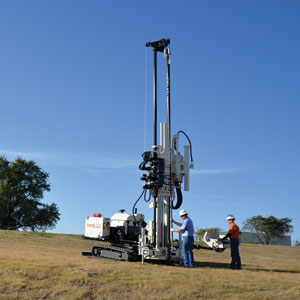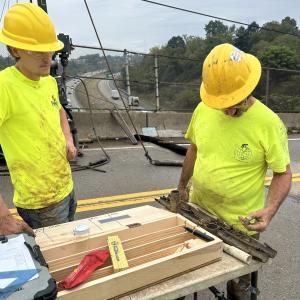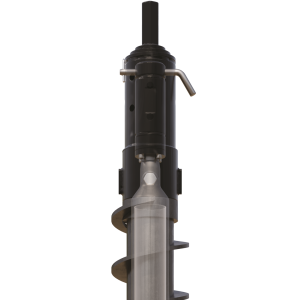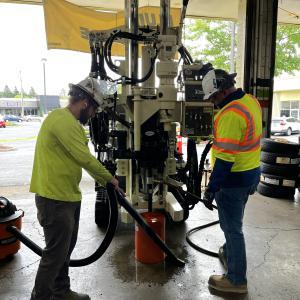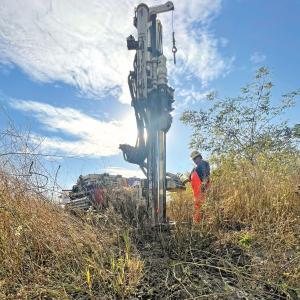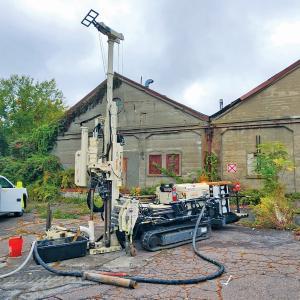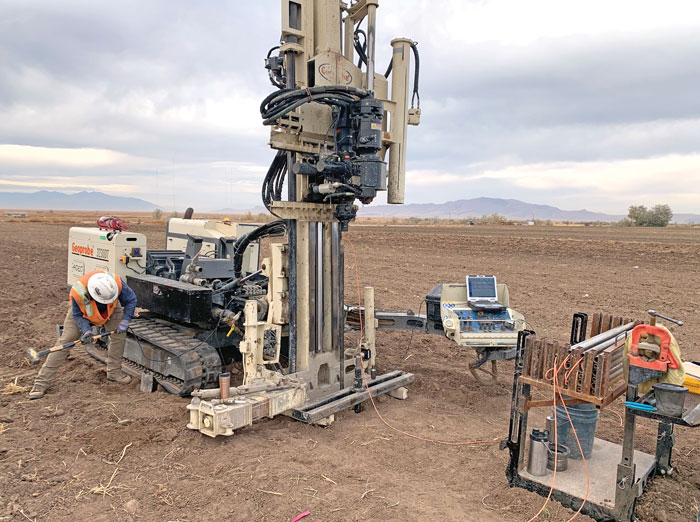
Applied Geotechnical Engineering Consultants (AGEC) employee Tyrell Gwilliam strikes the strike-plate to measure the shear wave velocity at 50 feet using the NEW Geoprobe® Seismic CPT module.
Focused on completing site investigations and writing soil reports to help clients eliminate risk as they build on a new site, Applied Geotechnical Engineering Consultants (AGEC) relies on their Geoprobe® 3230DT to handle the various soil conditions encountered around their home base in a suburb of Salt Lake City, Utah.
“We love the versatility of the 3230DT and its ability to handle every soil we have — clay, silt, sands, gravel, bedrock,” Derek Wolfe, engineer, said. “It pushes fast in clays and we can take it to the top of a mountain to do granite or sandstone coring.”
The geotechnical consulting firm found themselves increasingly fielding requests for seismic shear wave velocity. To meet the rising demand, Wolfe sought a solution to conveniently produce reliable shear wave velocity data.
“Changes to the international building code require more ground motion hazard analysis and it’s more convenient to use seismic cone penetration testing to measure shear wave response in the upper 100 feet,” Wolfe said.
Geoprobe® CPT specialists Troy Schmidt and Cory Harvey brought the NEW Geoprobe® Seismic CPT (SCPT) module to Utah for Wolfe and crew to examine.
“From the first test, the software and new cone technology was more reliable, easier to use, and provided more confidence we were bringing back good data,” Wolfe said. “With the new program Geoprobe® developed we can look at every wave collected and do a ‘sanity check’ to see if things make sense and be confident we have reliable data that can be analyzed back at the office.”
With the new Geoprobe® SCPT module, Wolfe and crew found the convenience they sought for site investigations. They’re also saving time which equates to cost savings.
“It’s streamlined our ability to collect data and be confident in it. We’re able to create models faster that are more representative of what is in the ground,” Wolfe said. “In the past it would take us three hours to analyze a full set of data. Now it can take 15 minutes. That’s a huge cost savings for us.”
Having completed side-by-side comparisons to what they’ve known to be good data and seeing it match up to the Geoprobe® SCPT data further instilled confidence in the system's dependability.
“We collected data using refraction microtremor (ReMi) on the same site and compared the data. They’ve agreed quite nicely. However, the Geoprobe® SCPT data has much higher resolution,” Wolfe said.
Being able to assess the raw data in real-time in the field also eliminates the need to remobilize and revisit a site.
“We can look at any of the 24 or 25 strikes while in the field and quickly assess if each wave arrival is happening when we would expect. It becomes apparent out in the field if there is an issue where previously we wouldn’t discover a concern until we were back in the office,” Wolfe said. “Before, on a few occasions, we would have to return to a site to re-push a cone because we doubted the results. Now we are more confident from the get go, which saves the clients bottom line.”
If they do run into an issue, they know they can depend on responsive expert customer service. The level of customer service was apparent from the first visit Troy and Cory made to Utah.
“We provided some suggestions for software commands and within a couple of weeks they incorporated those changes, which were critical for us to process and analyze the data,” Wolfe said. “We feel like they also have our best interests in mind because we have been heard and our opinions have been valued, which is a great advantage over many other companies.”
Contact Us
1835 Wall Street
Salina, Kansas 67401
Phone: (785) 825-1842
Related Articles
Geoprobe® interlocking split spoons meet the demands of geotechnical drillers using conventional rigs.
ID: 14620 | Date:
The 4.25 HSA Continuous Sampler is versatile and easy to use when collecting large sample volumes.
ID: 14619 | Date:
6011DT’s compact design and GH63 hammer let you reach depth in tight-access sites.
ID: 14615 | Date:
Geoprobe® international service expertise keeps the 7822DT working in the field, not sidelined in the shop.
ID: 14613 | Date:
Pullback power of 7822DT outperforms conventional rigs, overcoming sand friction when driving 4-inch casing.
ID: 14608 | Date:


